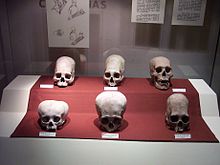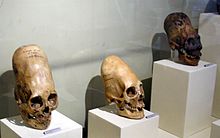- Artificial cranial deformation
-
Artificial cranial deformation, head flattening, or head binding is a form of permanent body alteration in which the skull of a human being is intentionally deformed. It is done by distorting the normal growth of a child's skull by applying force. Flat shapes, elongated ones (produced by binding between two pieces of wood), rounded ones (binding in cloth) and conical ones are among those chosen. It is typically carried out on an infant, as the skull is most pliable at this time. In a typical case, headbinding begins approximately a month after birth and continues for about six months.
Contents
History
 Maya modified skull exhibited at the Museo Nacional de Antropología e Historia, México.
Maya modified skull exhibited at the Museo Nacional de Antropología e Historia, México.
Intentional head molding producing extreme cranial deformations was once commonly practised in a number of cultures widely separated geographically and chronologically, and so was probably independently invented more than once. It still occurs today in a few groups, like the Vanuatu.
Early examples of intentional human cranial deformation predate written history and date back to 45,000 BC in Neanderthal skulls, and to the Proto-Neolithic Homo sapiens component (12th millennium BC) from Shanidar Cave in Iraq.[1][2] It occurred among Neolithic peoples in SW Asia.[3]
The earliest written record of cranial deformation dates to 400 BC in Hippocrates' description of the Macrocephali or Long-heads, who were named for their practice of cranial modification.[4]
The practice was also known among the Australian Aborigines, Maya, and certain tribes of North American natives, most notably the Chinookan tribes of the Northwest and the Choctaw of the Southeast.
In the Old World, Huns[5] and Alans[6] are also known to have practised similar cranial deformation. In Late Antiquity (AD 300-600), the East Germanic tribes who were ruled by the Huns, adopted this custom (Gepids, Ostrogoths, Heruli, Rugii and Burgundians). In western Germanic tribes, artificial skull deformations have rarely been found.[7]
The Native American group known as the Flathead did not in fact practise head flattening, but were named as such in contrast to other Salishan people who used skull modification to make the head appear rounder.[8] However, other tribes, including the Choctaw,[9] Chehalis, and Nooksack Indians, did practise head flattening by strapping the infant's head to a cradleboard.
Friedrich Ratzel in The History of Mankind[10] reported in 1896 that deformation of the skull, both by flattening it behind and elongating it towards the vertex, was found in isolated instances in Tahiti, Samoa, Hawaii, and the Paumotu group and occurring most frequently on Mallicollo in the New Hebrides, where the skull was squeezed extraordinarily flat.
Methods and types
Deformation usually begins just after birth for the next couple of years until the desired shape has been reached or the child rejects the apparatus (Dingwall, 1931; Trinkaus, 1982; Anton and Weinstein, 1999).
There is no established classification system of cranial deformations. Many scientists have developed their own classification systems, but none have agreed on a single classification for all forms that are seen (Hoshower et al., 1995).
In Europe and Asia, three main types of artificial cranial deformation have been defined by E.V. Zhirov (1941, p. 82):
- Round
- Fronto-occipital
- Sagittal.
Reasons
Cranial deformation was probably performed to signify group affiliation,[11] or to demonstrate social status. This may have played a key role in Egyptian and Mayan societies. Queen Nefertiti is often depicted with what may be an elongated skull, as is King Tutankhamen.[12] It could be aimed at creating a skull shape which is aesthetically more pleasing or associated with desirable attributes. For example, in the Nahai-speaking area of Tomman Island and the south south-western Malakulan, a person with an elongated head is thought to be more intelligent, of higher status, and closer to the world of the spirits.
Bibliography
- Ellen FitzSimmons, Jack H. Prost, Sharon Peniston, "Infant Head Molding, A Cultural Practice", Arch Fam Med, Vol 7, Jan/Feb 1998
- Adebonojo, F. O., "Infant head shaping". JAMA, 1991;265:1179.
- Henshen F. The Human Skull: A Cultural History . New York, NY: Frederick A Praeger, 1966
See Also
References
- ^ Trinkaus, Erik (April 1982). "Artificial Cranial Deformation in the in Shanidar 1 and 5 Neandertals". Current Anthropology 23 (2): 198–199. doi:10.1086/202808. JSTOR 2742361.
- ^ A. Agelarakis, "The Shanidar Cave Proto-Neolithic Human Population: Aspects of Demography and Paleopathology", Human Evolution, volume 8, no. 4 (1993), pp. 235-253.
- ^ Christopher Meiklejohn, Anagnostis Agelarakis, Ralph Solecki, Philip Smith, Canada), Peter Akkerman , "On the Origins of Cranial Artificial Deformation in SW Asia", Paleorient, Volume 18 (1992), pp. 83-97; K.O. Lorentz, Ubaid headshaping, in R.A. Carter and G. Philip, Beyond the Ubaid (2010), pp. 125-148.
- ^ Hippocrates upon Air, Water, and Situation: upon Epidemical Diseases, trans. Francis Clifton (1734), pp. 22-23.
- ^ Facial reconstruction of a Hunnish woman, Das Historische Museum der Pfalz, Speyer
- ^ Bachrach, Bernard S., A history of the Alans in the West: from their first appearance in the sources of classical antiquity through the early Middle Ages, U of Minnesota Press (1973), pp. 67-69
- ^ Doris Pany and Karin Wiltschke-Schrotta, Artificial cranial deformation in a migration period burial of Schwarzenbach, Lower Austria, VIAVIAS, no. 2 (Vienna Institute for Archaeological Science 2008), pp. 18-23.
- ^ http://www.americanindians.com/
- ^ http://www.accessgenealogy.com/native/tribes/choctaw/chostawhist.htm
- ^ Ratzel, Friedrich. The History of Mankind. (London: MacMillan, 1896). URL: www.inquirewithin.biz/history/american_pacific/oceania/dress-ornament.htm accessed 4 October 2009.
- ^ Gerszten and Gerszten, 1995; Hoshower et al., 1995; Tubbs, Salter, and Oaks, 2006.
- ^ Gerszten and Gerszten, 1995
External links
- A short discussion of cranial deformation
- A Comparison of Images of Kushans from Coins and Sculpture
- Mathematical Analysis of Artificial Cranial Deformation
- Reconstruction of an Ostrogoth woman from a skull (intentionally deformed), discovered in Globasnitz (Carinthia, Austria) : [1], [2], [3], [4], [5].
Categories:- Body modification
- Traditions
- Skull
Wikimedia Foundation. 2010.






